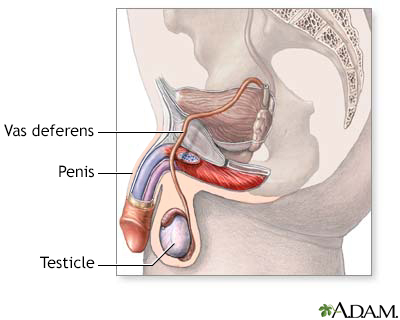Sertoli-Leydig cell tumor
Sertoli-stromal cell tumor; Arrhenoblastoma; Androblastoma; Ovarian cancer - Sertoli-Leydig cell tumor
Sertoli-Leydig cell tumor (SLCT) is a rare cancer of the ovaries. The cancer cells produce and release a male sex hormone called testosterone.
Images

Causes
The exact cause of this tumor is not known. Changes (mutations) in genes may play a role.
SLCT occur most often in young women 20 to 30 years old. But the tumor can occur at any age.
Symptoms
The Sertoli cells are normally located in the male reproductive glands (the testes). They feed sperm cells. The Leydig cells, also located in the testes, release a male sex hormone.
These cells are also found in a woman's ovaries, and in very rare cases lead to cancer. SLCT starts in the female ovaries, mostly in one ovary. The cancer cells release a male sex hormone. As a result, the woman may develop symptoms such as:
- A deep voice
- Enlarged clitoris
- Facial hair
- Loss in breast size
- Stopping of menstrual periods
Pain in the lower belly (pelvic area) is another symptom. It occurs due to the tumor pressing on nearby structures.
Exams and Tests
The health care provider will perform a physical exam and a pelvic exam, and ask about the symptoms.
Tests will be ordered to check the levels of female and male hormones, including testosterone.
An ultrasound or CT scan will likely be done to find out where the tumor is and its size and shape.
Treatment
Surgery is done to remove one or both ovaries.
If the tumor is advanced stage, chemotherapy or radiation therapy may be done after surgery.
Outlook (Prognosis)
Early treatment results in a good outcome. Feminine characteristics usually return after surgery. But male characteristics resolve more slowly.
For more advanced stage tumors, outlook is less positive.
Related Information
TestosteroneOvarian cancer
Virilization
References
Fletcher CDM. Tumors of the female genital tract. In: Fletcher CDM, ed. Diagnostic Histopathology of Tumors. 5th ed. Philadelphia, PA: Elsevier; 2021:chap 13.
Penick ER, Hamilton CA, Maxwell GL, Marcus CS. Germ cell, stromal, and other ovarian tumors. In: DiSaia PJ, Creasman WT, Mannel RS, McMeekin DS, Mutch DG, eds. Clinical Gynecologic Oncology. 9th ed. Philadelphia, PA: Elsevier; 2018:chap 12.
Smith RP. Sertoli-Leydig cell tumor (arrhenoblastoma). In: Smith RP, ed. Netter's Obstetrics & Gynecology. 3rd ed. Philadelphia, PA: Elsevier; 2018:chap 158.
BACK TO TOPReview Date: 4/29/2022
Reviewed By: Todd Gersten, MD, Hematology/Oncology, Florida Cancer Specialists & Research Institute, Wellington, FL. Review provided by VeriMed Healthcare Network. Also reviewed by David C. Dugdale, MD, Medical Director, Brenda Conaway, Editorial Director, and the A.D.A.M. Editorial team.

Health Content Provider
06/01/2025
|
A.D.A.M., Inc. is accredited by URAC, for Health Content Provider (www.urac.org). URAC's accreditation program is an independent audit to verify that A.D.A.M. follows rigorous standards of quality and accountability. A.D.A.M. is among the first to achieve this important distinction for online health information and services. Learn more about A.D.A.M.'s editorial policy, editorial process and privacy policy. A.D.A.M. is also a founding member of Hi-Ethics. This site complied with the HONcode standard for trustworthy health information from 1995 to 2022, after which HON (Health On the Net, a not-for-profit organization that promoted transparent and reliable health information online) was discontinued. |
The information provided herein should not be used during any medical emergency or for the diagnosis or treatment of any medical condition. A licensed medical professional should be consulted for diagnosis and treatment of any and all medical conditions. Links to other sites are provided for information only -- they do not constitute endorsements of those other sites. © 1997- 2024 A.D.A.M., a business unit of Ebix, Inc. Any duplication or distribution of the information contained herein is strictly prohibited.
